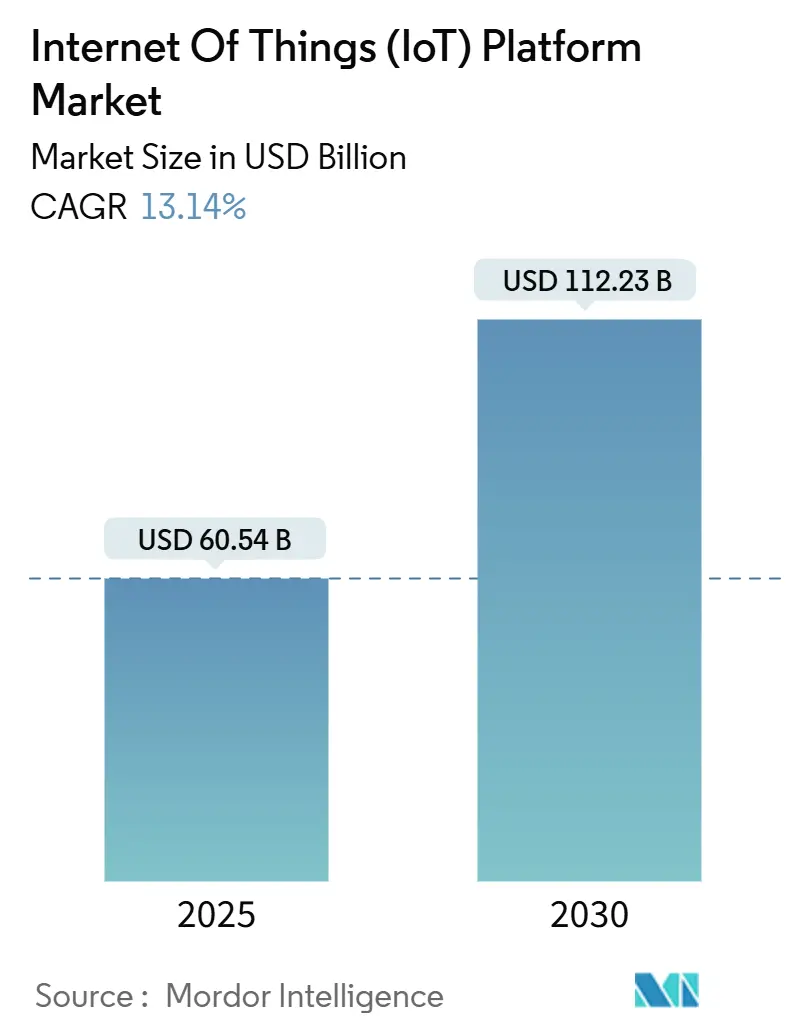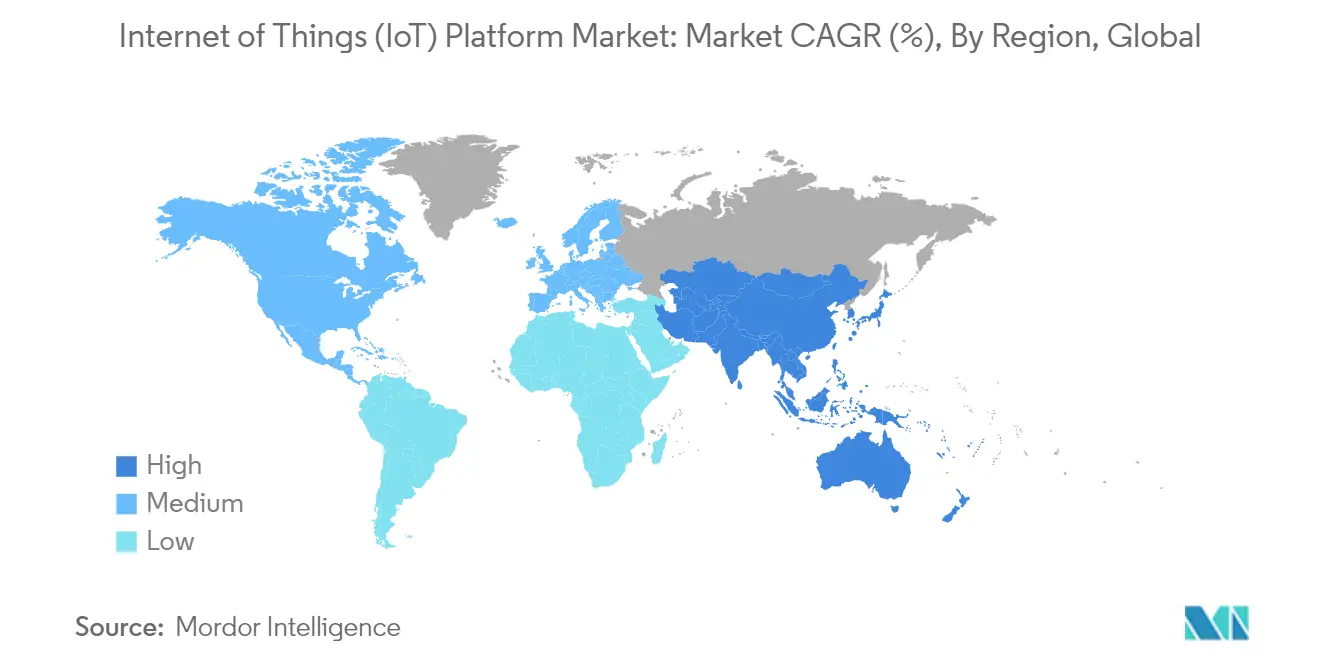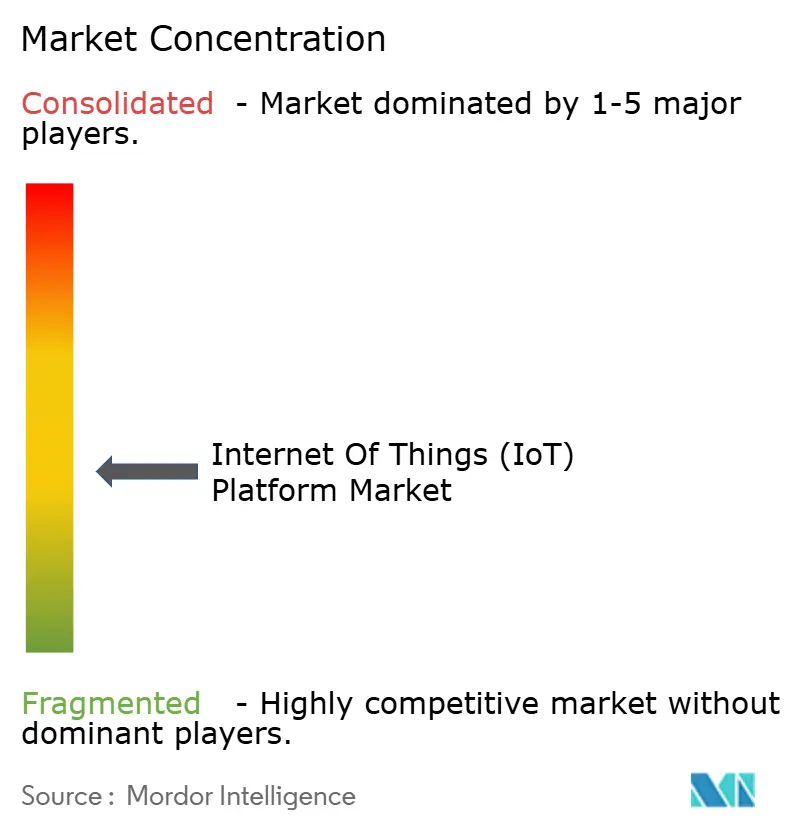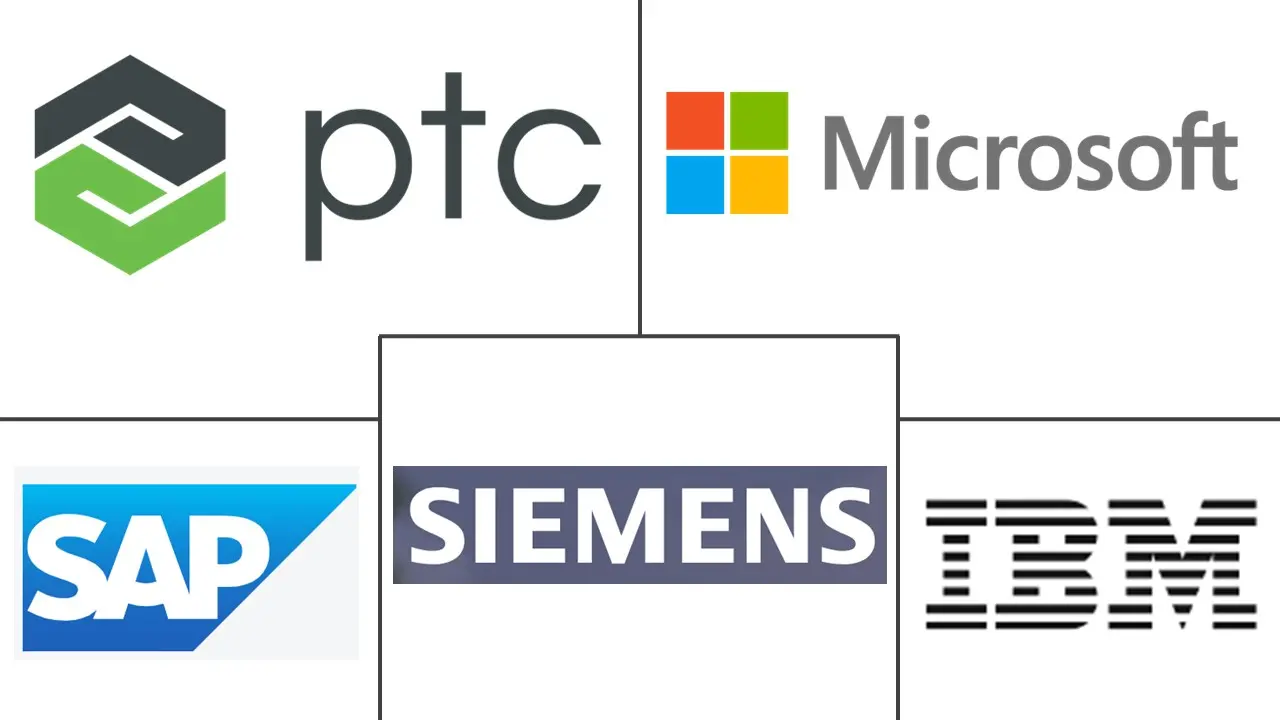Internet Of Things (IoT) Platform Market Size and Share

Internet Of Things (IoT) Platform Market Analysis by Mordor Intelligence
The Internet Of Things Platform Market size is estimated at USD 60.54 billion in 2025, and is expected to reach USD 112.23 billion by 2030, at a CAGR of 13.14% during the forecast period (2025-2030).
The IoT platform market is experiencing significant growth, driven by the increasing adoption of industrial automation, enhanced connectivity, and the growing reliance on data-driven decision-making across diverse sectors. Furthermore, the integration of advanced technologies, including artificial intelligence (AI) and machine learning (ML), is augmenting the capabilities of IoT platforms, enabling more efficient operations and informed decision-making processes.
- The IoT market is witnessing a substantial increase in connected devices, ranging from consumer electronics to industrial sensors. IoT platforms are becoming critical for ensuring device connectivity, managing data, and automating operations. The growing adoption of smart thermostats, security systems, smart grids, and connected lighting is further driving the demand for these platforms. Additionally, the widespread deployment of IoT-enabled devices across industries such as healthcare, automotive, and agriculture is necessitating robust IoT platforms capable of handling large-scale data processing and delivering actionable insights in real-time.
- The IoT platform market is experiencing substantial growth, driven by the increasing adoption of automation and big data analytics. Organizations across various industries are leveraging IoT-driven automation and advanced data analytics to enhance operational efficiency, improve decision-making processes, and strengthen predictive capabilities. The integration of artificial intelligence (AI), machine learning (ML), edge computing, and real-time data processing is further accelerating the adoption of IoT platforms. This upward trajectory is expected to persist as enterprises prioritize digital transformation and seek scalable solutions to manage complex data ecosystems effectively.
- The IoT platform market is witnessing significant growth, driven by increased investments in IoT technologies across various industries. Organizations are allocating higher budgets to IoT initiatives to enhance connectivity, automation, real-time analytics, and digital transformation efforts. The development of smart cities, advancements in industrial automation, and the adoption of cloud-based IoT solutions are further contributing to the expansion of the market.
- This growth is also supported by the rising adoption of IoT in emerging economies, where collaborations between governments and private enterprises are facilitating the implementation of IoT-driven solutions for infrastructure development and public services. Moreover, advancements in 5G technology are anticipated to further accelerate the adoption of IoT platforms by enabling faster and more reliable connectivity.
- The IoT platform market is characterized by significant fragmentation, with numerous vendors, technologies, and protocols operating across various industries and regions. While this fragmentation encourages innovation and competition, it also presents substantial challenges related to interoperability, standardization, and integration for businesses seeking to implement IoT solutions. The diversity of hardware, software ecosystems, and proprietary architectures complicates efforts to achieve seamless connectivity, thereby limiting the scalability of IoT platforms. Consequently, organizations often encounter obstacles in deploying cost-effective and efficient IoT solutions, which can impede their ability to fully capitalize on the transformative potential of IoT technologies in driving operational efficiencies and innovation.
Global Internet Of Things (IoT) Platform Market Trends and Insights
Mobility End-User Industry Segment is Expected to Witness Significant Growth in the Market
- In the mobility sector, IoT platforms are not just growing; they're reshaping transportation operations and elevating user experiences. Central to Mobility as a Service (MaaS), these platforms seamlessly integrate ride-hailing, car-sharing, bike-sharing, and public transit. This evolution, moving away from private vehicle ownership to shared, on-demand mobility, is largely a response to urbanization, congestion, and environmental concerns.
- With IoT platforms at the helm, vehicle-to-vehicle (V2V) and vehicle-to-infrastructure (V2I) communications are revolutionizing traffic management, safety, and fuel efficiency. For connected vehicles, IoT facilitates real-time data exchange, predictive maintenance, and navigation.
- The rise of electric vehicles (EVs) has increased the need for IoT platforms to manage charging infrastructure, monitor battery health, and optimize energy usage. Germany has emerged as the top European market for plug-in electric car sales, as reported by ACEA. In 2024, Germany saw approximately 572,500 new registrations for plug-in electric vehicles in the passenger car segment, with battery-electric vehicles making up roughly 66.5 percent of these sales.
- IoT also supports vehicle-to-grid (V2G) technology, allowing EVs to interact with the power grid. Governments worldwide are promoting EV adoption through subsidies and regulations, boosting demand for IoT solutions. By 2030, the Indian government aims for 30% of new vehicle sales to be electric.
- As technology continues to evolve and the appetite for smarter, sustainable transportation solutions grows, the IoT platform market in the mobility sector stands on the brink of further expansion.

North America is Expected to Hold Significant Market Share
- In North America, the US and Canada are at the forefront, with industries like manufacturing, healthcare, logistics, smart cities, and energy increasingly adopting IoT platforms. These sectors are harnessing IoT for automation, predictive maintenance, and AI analytics to streamline operations. For instance, manufacturing giants are leveraging GE’s Predix and Siemens MindSphere for real-time machine oversight.
- The surge in remote patient monitoring (RPM) and the proliferation of smart medical devices in North America underscore the healthcare sector's growing embrace of IoT. Companies like Medtronic and Philips are at the helm, utilizing IoT for their connected medical devices and patient monitoring solutions.
- The Food and Drug Administration (FDA) in the US has historically approved 18 Virtual Reality (VR) and Augmented Reality (AR) medical devices for marketing. However, there's been a notable uptick in recent years, with a growing number of medical devices incorporating VR/AR receiving approvals.
- The deployment of 5G networks and edge computing in North America is transforming IoT connectivity by enabling faster, more reliable connections, reducing latency, and improving real-time processing. Telecom leaders such as Verizon, AT&T, and T-Mobile are heavily investing in nationwide 5G rollouts, boosting IoT adoption in smart cities, factories, and homes and driving market growth.

Competitive Landscape
Leading technology companies such as Microsoft, AWS, Google Cloud, IBM, Cisco, and Huawei dominate the market with comprehensive IoT platform solutions.
Competition is driven by ongoing innovation, the integration of artificial intelligence (AI), and the formation of strategic partnerships.
IoT platforms are differentiated by their industry-specific focus, integration capabilities, and scalability, with firms competing in areas such as edge computing, AI-powered analytics, and seamless cloud integration.
Several providers implement tiered pricing strategies, including pay-per-use, freemium, and subscription-based models, thereby intensifying pricing pressures.
Vendors are actively reducing platform access costs to enhance market competitiveness.
Organizations are making significant investments in IoT security, AI, and cloud infrastructure to sustain their competitive advantage.
The strong market presence of major technology firms, coupled with price competition and feature differentiation, results in a high level of competitive rivalry.
Overall, the intensity of competitive rivalry among the vendors is expected to be high over the forecast period.
Internet Of Things (IoT) Platform Industry Leaders
-
IBM Corporation
-
Microsoft Corporation
-
PTC Inc.
-
SAP SE
-
Siemens AG
- *Disclaimer: Major Players sorted in no particular order

Recent Industry Developments
- November 2024: Oracle has strengthened its collaboration with Vodafone Business IoT, integrating global IoT connectivity into Oracle’s Enterprise Communications Platform (ECP) for its industry applications. Leveraging the robust performance and security of Oracle Cloud Infrastructure, ECP employs edge architecture, equipping businesses with immediate connectivity and near real-time data insights to drive vital new services.
- November 2024: ABB, in partnership with Microsoft, is harnessing generative Artificial Intelligence (AI) to tackle intricate challenges within the industrial sector. Utilizing Microsoft's Azure OpenAI Service, ABB has infused generative AI into its Genix platform, giving rise to the Genix Copilot. This innovative tool allows users to engage in natural language conversations, facilitating real-time answers to pivotal queries.
Global Internet Of Things (IoT) Platform Market Report Scope
The market is defined by the revenue accrued from sales of IoT (Internet of Things) Platform solutions offered by market vendors to companies across the globe.
The Internet of Things platform market is segmented by deployment (on-premise, cloud/SaaS), by type of platform (application enablement, device management, advanced analytics, cloud storage/IaaS, and connectivity), by end-user industry (industrial, connected buildings, smart home, mobility, medical, and other end-user applications), by geography (North America, Europe, Asia Pacific and the Rest of the World). The market sizes and forecasts are provided in terms of value in (USD) for all the above segments.
| On-premise |
| Cloud/Saas |
| Application Enablement |
| Device Management |
| Advanced Analytics |
| Cloud Storage/IaaS |
| Connectivity |
| Industrial |
| Connected Building |
| Smart Home |
| Mobility |
| Medical |
| Other End-user Industries |
| North America |
| Europe |
| Asia |
| Australia and New Zealand |
| Latin America |
| Middle East and Africa |
| By Deployment | On-premise |
| Cloud/Saas | |
| By Type of Platform | Application Enablement |
| Device Management | |
| Advanced Analytics | |
| Cloud Storage/IaaS | |
| Connectivity | |
| By End-user Industry | Industrial |
| Connected Building | |
| Smart Home | |
| Mobility | |
| Medical | |
| Other End-user Industries | |
| By Geography*** | North America |
| Europe | |
| Asia | |
| Australia and New Zealand | |
| Latin America | |
| Middle East and Africa |
Key Questions Answered in the Report
How big is the Internet Of Things Platform Market?
The Internet Of Things Platform Market size is expected to reach USD 60.54 billion in 2025 and grow at a CAGR of 13.14% to reach USD 112.23 billion by 2030.
What is the current Internet Of Things Platform Market size?
In 2025, the Internet Of Things Platform Market size is expected to reach USD 60.54 billion.
Who are the key players in Internet Of Things Platform Market?
IBM Corporation, Microsoft Corporation, PTC Inc., SAP SE and Siemens AG are the major companies operating in the Internet Of Things Platform Market.
Which is the fastest growing region in Internet Of Things Platform Market?
Asia Pacific is estimated to grow at the highest CAGR over the forecast period (2025-2030).
Which region has the biggest share in Internet Of Things Platform Market?
In 2025, the North America accounts for the largest market share in Internet Of Things Platform Market.
What years does this Internet Of Things Platform Market cover, and what was the market size in 2024?
In 2024, the Internet Of Things Platform Market size was estimated at USD 52.59 billion. The report covers the Internet Of Things Platform Market historical market size for years: 2019, 2020, 2021, 2022, 2023 and 2024. The report also forecasts the Internet Of Things Platform Market size for years: 2025, 2026, 2027, 2028, 2029 and 2030.
Page last updated on:
Internet Of Things (IoT) Platform Market Report
Statistics for the 2025 Internet Of Things (IoT) Platform market share, size and revenue growth rate, created by Mordor Intelligence™ Industry Reports. Internet Of Things (IoT) Platform analysis includes a market forecast outlook for 2025 to 2030 and historical overview. Get a sample of this industry analysis as a free report PDF download.



